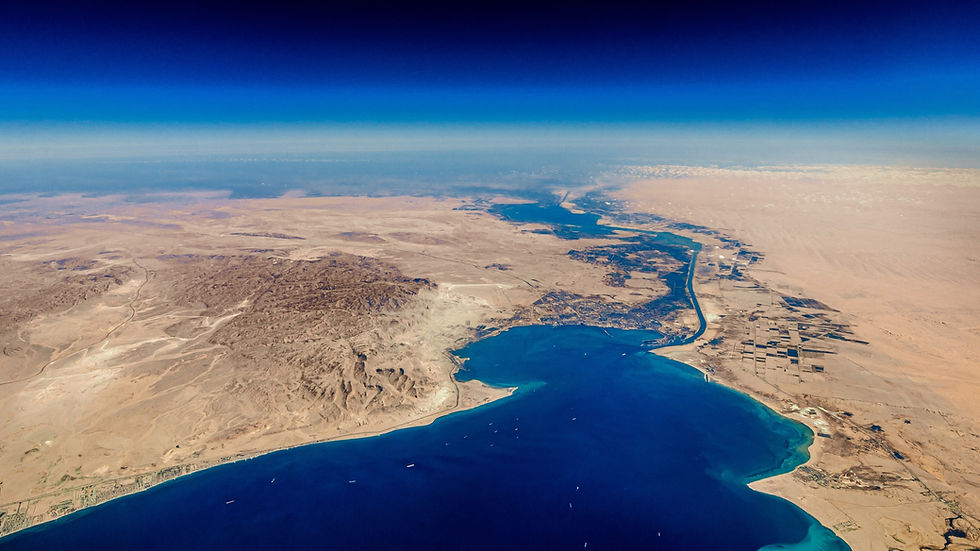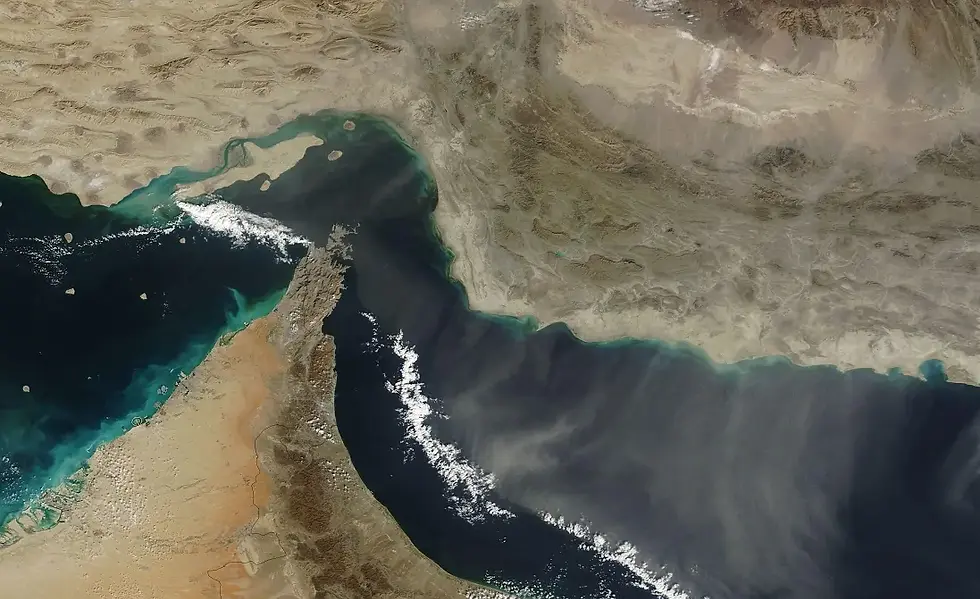Two sea lanes on which oil is playing its world war
- Clara Arias
- 29 abr 2024
- 7 Min. de lectura
Actualizado: 3 oct 2024
Conflicts and tensions in the Middle East jeopardize oil shipping in the region and threaten to redirect shipping routes

Aerial view of the Suez Canal
For centuries, the sea has been the great highway of international trade, transporting more than 80% of traded goods. Maritime transport is often metaphorically called the “heart” of world trade, since it has different arteries –choke points– scattered around the planet, through which a large part of the goods flow or, at least, a large part of the strategic ones –such as energy–. Of this large number of straits or canals in different parts of the world, two of them, and the most important in terms of oil transport, are in the Middle East: the Suez Canal and the Strait of Hormuz.
THE CREATION OF SUEZ CANAL
The creation of a canal linking the Red Sea with the Mediterranean had been an old aspiration of the civilizations that have populated the Suez isthmus. The first known attempts date back to the 19th century BC. The pharaoh Sesostris III ordered the construction of a canal connecting the Nile with the Red Sea, which ended up being a narrow channel, but with enough space for the vessels of the time. The route, later christened the "Pharaohs' Canal", was widely used until the middle of the 7th century BC, but the desert had gained too much ground over the sea and blocked the outlet.
During the Roman occupation of Egypt, especially under Trajan, the canal underwent significant improvements that boosted trade. However, after the Romans left, the canal was abandoned. In the 8th century, during the Muslim domination, the Caliph Omar undertook its recovery, but after a century of operation it was reclaimed again by the desert.

Its existence remained hidden for a thousand years, until Napoleon's arrival in 1798. Among the group of scholars accompanying him was the engineer Jean-Baptiste Lepère, who was commissioned by Napoleon to inspect the Suez isthmus to check the feasibility of opening a canal to allow the passage of troops and goods to the East. Despite discovering traces of the ancient canal of the Pharaohs, Lepère determined that its construction was impossible, since, according to his calculations, there was a difference of nine meters between the water level of the Red Sea and that of the Mediterranean.
As the years went by, the need to open this sea route only increased, especially with the moment of development that Europe was going through in the 19th century. Trade with East Asia had ceased to be a luxury and had become vital to the economic growth of the European powers. The most common route for transporting goods between East and West was by sea, a long journey of more than four months around southern Africa. There was also an overland route through the Sinai desert, a journey made unsafe by gangs of highwaymen and impractical because of the limited volume of cargo that the caravans could carry. In 1845 an additional route was added: the first Egyptian railway line connecting Alexandria with the port of Suez. The service was very useful for passenger transport, but insufficient for freight transport: it could not compete with the new steamships, much faster and with greater cargo capacity.
For all these reasons, the resumption of studies on the opening of a canal in the Suez isthmus was not long in coming. The most important were those carried out by Linant de Bellefonds, a French engineer and advisor to the Egyptian government, and by the team led by Prosper Enfantin. Both proved that Lepère's calculations were wrong: there was hardly any difference between the water level of the Red Sea and the Mediterranean, so they concluded that the construction of the canal was technically possible.

Once it had been demonstrated that the construction of the canal was feasible from a topographical point of view, it had to be proven that it was also feasible from an economic point of view. The French diplomat Ferdinand de Lesseps was in charge of convincing the Egyptian leaders and seeking financing. Construction finally began in 1859 and involved more than 1.5 million workers. It was in February 1867 that the first ship crossed the canal, but it was not officially inaugurated until 1969.
At that time, the Suez Canal was only eight meters deep, 22 meters wide at the bottom and from 61 to 91 meters wide on the surface, so that in its first years of operation, around 3,000 groundings were recorded due to its narrowness and tortuousness, so that in the following years several expansions were carried out.
THE IMPORTANCE OF SUEZ CANAL
The construction of the Suez Canal is considered one of the most important works of the 19th century and was the first time in history that excavation machinery was used. Its creation meant the implementation of one of the most important trade routes in the world.
The main alternative route to the canal is surrounding the Cape of Good Hope (Africa), but it takes almost nine days longer than the Suez Canal route.
Other countries have tried to create alternative canals or overland routes that would allow them to make an economic profit, but they are not as viable. On the one hand, Israel and the United Arab Emirates (UAE) have raised the possibility of building a new canal from the Israeli port of Eilat across the Negev desert to the Mediterranean, but the costs of the project make it unfeasible. On the other hand, the incorporation of the London-Istanbul-Beijing railway into the “New Silk Road” megaproject is being considered, which has been presented by the Chinese and Turkish authorities as a safe option, but there are also many doubts about its feasibility and profitability.
For the time being, the Suez Canal remains the main maritime route between Asia and Europe, which is reflected in the number of ships and tons transported. Over its 193 kilometers in length, more than 19,000 ships pass through each year. The main goods that cross the canal's waters are oil, cereals, minerals, coal and other types of foodstuffs that travel from the West to the East and vice versa.
In addition to these goods shown in the chart, approximately 8% of liquefied natural gas is transported through the Suez Canal.
THE STRAIT OF ORMUZ
The Strait of Hormuz is a canal of just 33 kilometers of water separating two shores: Iran´s and United Arab Emirates´, the Gulf of Oman and the Persian Gulf. It is undoubtedly one of the world's most strategic sea passages, connecting Middle Eastern oil producers with key markets in Asia Pacific, Europe and North America.
With its 160 kilometers long, the Strait of Hormuz is, unlike the Suez Canal, a natural sea passage and is not controlled by any country. It links the Persian Gulf with the Gulf of Oman –where countries such as Iran, Kuwait, Saudi Arabia, Bahrain, Qatar and the United Arab Emirates are located– and the Arabian Sea.

Aerial view of the Strait of Hormuz
The strait has been gaining importance as the oil industry has developed around it, to the point that due to the dense traffic of cargo ships, measures were established to avoid collisions and two lanes were created, about two miles wide, separated by a median that ordered the maritime traffic. It is the only way to move oil from the Persian Gulf to the rest of the oceans and, although it has limited traffic due to its only two lanes of only 3 kilometers, approximately one fifth of the global production of this fuel circulates through its waters.
For this reason, any threat to the Strait of Hormuz, from possible resource theft to drone attacks, could directly affect the oil market. Through the study of figures of the US sanctions that stopped traffic in 2019, it is estimated that, if this route were to completely block its traffic, the global oil supply would fall by 20%, in the least case scenario.
CONFLICTS IN SUEZ AND HORMUZ
The Suez Canal already suffered a major crisis in 1956, caused by the nationalization of the Canal by Egypt. This conflict pitted Egypt against the alliance formed by Great Britain, France and Israel, which led to a crisis in the Canal, also known as the Sinai War. Another problem that the canal has faced has been the blockage of the waterway caused by the stranding of ships, the most prominent occurred between March 23 and 29, 2021, when the container ship “Ever Given” blocked the sea passage with its 400 meters in length and 18,000 containers on board, and formed a huge traffic jam.
In addition, Yemen´s Houthis attacks on ships in the Red Sea had a major impact on the transit of goods through the Suez Canal, with the transport volume dropping by 52.5% per week since the first attack in November 2023. On the contrary, these assaults by Yemeni rebels caused vessels to prefer the Cape of Good Hope route, via the South African coast, which rose by 67%.
Regarding the Strait of Hormuz, due to its geopolitical and strategic importance, any blockade could prove fatal on a global level. The recent escalation of tensions between Iran and Israel has resulted in the Iranian Revolutionary Guard seizing a vessel in the Persian Gulf, which is believed to be linked to Israel. Through the official Iranian news agency Irna, the Iranian government has confirmed the seizure of the vessel and its transfer to its territorial waters. Iran's involvement in the war between Israel and Hamas could jeopardize the supply of crude oil and global oil prices, as well as the safety and transit of ships in Hormuz. Likewise, if Israel persists in its attacks against Iran, it could decide to block the flow of fuel, something that has already happened in the past and could happen again, giving rise to a new unprecedented resource crisis.



Comentarios